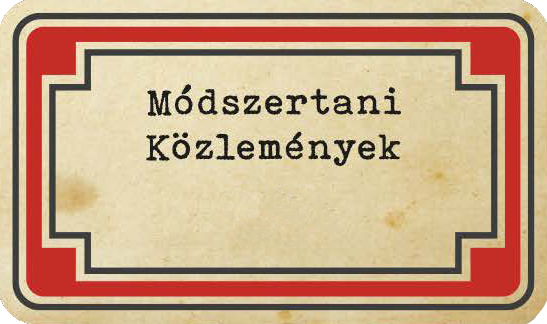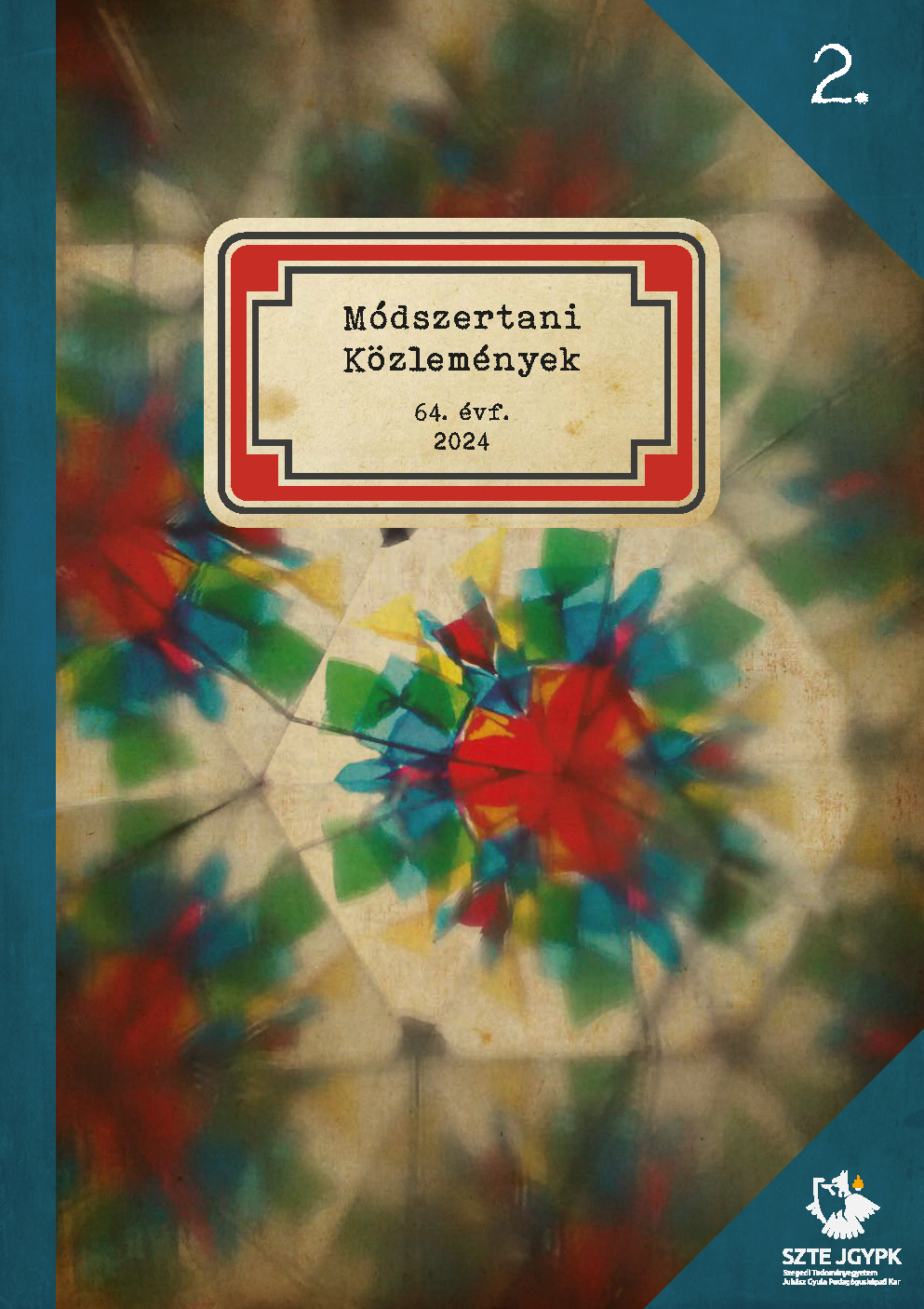A morfológiai tudatosság mérése és fejlesztésének hatása a szövegértési képességre 9. osztályos szakiskolai tanulók körében
Main Article Content
Abstract
Morphological awareness is the ability to manipulate the structure of words (Carlisle, 1995; Török and Hódi, 2015). Several international studies confirm the importance of developing morphological awareness and its impact on text comprehension (Gillon és Kirk 2009; Bernstein, Flipse, Jin és Odegard, 2020 stb.) In Hungary research is limited to the early stages of language acquisition (Varga, Pásztor és Steklács, 2019) so the morphological awareness of secondary school students and the possibilities of its development remain to be explored. International research finds the assessment and development of morphological awareness relevant as well as its impact on reading comprehension until adulthood (Wilson-Fowler és Apel, 2015; Binder és Tighe, 2015). A survey among Hungarian vocational secondary school students could provide significant results about assessing and developing morphological awareness and its effects on reading comprehension. The main question of the research is whether morphological awareness of secondary school students can be assessed and developed in a school environment, and whether its development has a positive impact on students’ reading comprehension skills. The participants in this research are 9th grade students in a vocational school. Classes of 30 and 28 students form the experimental and control groups of the research. The results of the research demonstrate that it is possible to assess and develop the morphological awareness of 9th grade students in vocational schools through classroom activities. Furthermore, that the development of morphological awareness has a positive effect on reading comprehension.
Article Details
References
Adamikné Jászó Anna (2003): Csak az ember olvas. Tinta Kiadó, Budapest.
Adamikné Jászó Anna (2006): Az olvasás múltja és jelene. Trezor Kiadó, Budapest.
Apel, K., Wilson-Fowler, E., Brimo, D. és Perrin, N. (2012): Metalinguistic contributions to reading and spelling in second and third grade students. Reading and Writing: An Interdisciplinary Journal, 25. 6. sz. 1283–1305.
Bartha Blanka (2024): A morfológiai tudatosság mérésének és fejlesztésének lehetőségei középiskolás korban. Anyanyelv-pedagógia, 17. 3. sz. 31-43.
Bernstein, S. E., Flipse, J. L., Jin, Y. és Odegard, T. N. (2020). Word and sentence level tests of morphological awareness in reading. Reading and Writing, 33. 1591–1616.
Binder, K. S. és Tighe, E. L. (2015): An investigation of morphological awareness and processing in adults with low literacy. Applied Psycholinguistics, 36. 2. sz. 245–273.
Carlisle, J. F. és Nomanbhoy, D. (1993): Phonological and morphological development. Applied Psycholinguistics, 14. 2. sz. 177–195.
Carlisle, J. F. (1995): Morphological awareness and early reading achievement. In: Feldman Louis (szerk.): Morphological aspects of language processing. Lawrence Erlbaum Associates. Mahwah, NJ. 189–209.
Carlisle, J. F. (2000): Awareness of the structure and meaning of morphologically complex words: Impact on reading. Reading and Writing: An Interdisciplinary Journal, 12. 3. sz. 169–190.
Csapó Benő (2015): A magyar közoktatás problémái az adatok tükrében. Iskolakultúra, 25. 7–8. sz. 4–17.
Csépe Valéria (2006): Az olvasó agy. Akadémiai Kiadó. Budapest.
Ehri, L. C. (2005): Learning to read words: Theory, findings and issues. Scientific Studies of Reading, 9. 2. sz. 167–188.
Gillon, G. T és Kirk, C. (2009): Integrated morhplogical awareness intervention as a tool for improving lliteracy. Language, Speech and Hearing Services in Schools, 40. 341–351.
Gósy Mária (2005): Pszicholingvisztika. Osiris Kiadó, Budapest.
Laczkó Mária (2008): Anyanyelvi szövegértés és grammatikai tudás. http://epa.oszk.hu/00000/ 00035/00120/2008-01-ta-Laczko-Anyanyelvi.html (2024.04.14.)
Mahony, D., Singson, M. és Mann, V. (2000): Reading ability and sensitivity to morphological relations. Reading and Writing: An Interdisciplinary Journal, 12. 3. sz. 191–218.
Nagy, W. E., Berninger, V., Abbott, R., Vaughan, K. és Vermeulen, K. (2003): Relationship of morphology and other language skills to literacy skills in at-risk second-grade readers and at-risk fourth-grade writers. Journal of Educational Psychology, 95. 4. sz. 730–742.
Nagy, W. E., Carlisle, J. F. és Goodwin, A. P. (2014): Morphological knowledge and literacy acquisition. Journal of Learning Disabilities, 47. 1. sz. 3–12.
Plaut, D. C. és Gonnermann, L. M. (2000): Are non-semantic morphological effects incompatible with a distributed connectionist approach to lexical processing? Language and Cognitive Processes, 15. 4–5. sz. 445–485.
Lukács Ágnes, Pléh Csaba, Kas Bence és Thuma Orsolya (2014): A szavak mentális reprezentációja és az alaktani feldolgozás. In: Pléh Csaba és Lukács Ágnes (szerk.): Pszicholingvisztika 1. Akadémiai Kiadó. Budapest. 166–239.
Pléh Csaba (2011): A tudatos és a nem-tudatos problémája a kísérleti pszichológia és a kognitív tudomány tükrében. Magyar Pszichológiai Szemle, 66. 1. sz. 47–74.
Pomázi Bence (2018): Egy nonszensz vers fordításainak alkalmazhatósága az általános iskolai nyelvtanoktatásban. In: Balázs Géza és Lengyel Klára (szerk.): Grammatika és oktatás – időszerű kérdések: Struktúra, funkció, szemiotika, hálózat. Magyar szemiotikai tanulmányok 41–42. ELTE BTK Mai Magyar Nyelvi Tanszék, Inter Nonprofit Kft., Magyar Szemiotikai Társaság, Budapest. 197–201.
Rathvon, N. (2004): Early reading assessment: a practitioner’s handbook. The Guilford Press, New York.
Steklács János, Szabó Ildikó és Szinger Veronika (2010): Olvasási nehézségekkel küzdő tizenévesek tanítása Európában (ADORE-jelentés). Anyanyelv-pedagógia, 3. 4. sz. http://www. anyanyelv-pedagogia.hu/cikkek.php?id=292 (2024.04.14.)
Tóth László (2003): Narratívum és megértés: Pszichológiai sajátosságok a narratív szöveg megértésének fejlődésében az általános iskolai tanulóknál. Habilitációs értekezés. Kézirat. Debreceni Egyetem Bölcsészettudományi Kar Pszichológiai Intézet. Debrecen.
Török Tímea és Hódi Ágnes (2015): A morfológiai tudatosság fejlődése, mérési lehetőségei és az olvasás-szövegértéssel való kapcsolata. Anyanyelv-pedagógia, 8. 1. sz. https://www.anyanyelv- pedagogia.hu/cikkek.php?id=551 (2024.04.14.)
Varga Szilvia, Pásztor Attila és Steklács János (2019): A szövegértés és a morfológiai tudatosság számítógép-alapú fejlesztése alsó tagozaton. Iskolakultúra, 29. 8. sz. 94–106.
Varga Szilvia és Steklács János (2019): A morfológiai tudatosság és összefüggése a szövegértő olvasás képességével második osztályos korban: egy próbamérés tanulságai. In: Bóna Judit és Horváth Viktória (szerk.): Az anyanyelv-elsajátítás folyamata hároméves kor után. ELTE Eötvös Kiadó. Budapest. 107–127.
Wilson-Fowler, E. és Apel, K. (2015): Influence of morphological awareness on college students’ literacy skills: a path analytic approach. Journal of Literacy Research, 47. 3. sz. 405–432.

